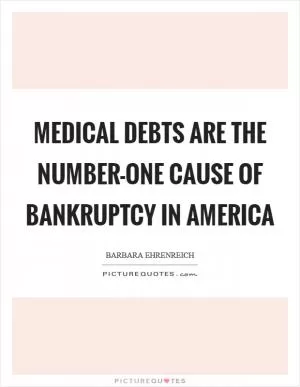Medical debts are the number one cause of bankruptcy in America

Medical debts are the number one cause of bankruptcy in America
Barbara Ehrenreich is a renowned social critic and author who has written extensively on issues related to poverty, healthcare, and economic inequality in America. In her book "Nickel and Dimed: On (Not) Getting By in America," Ehrenreich explores the struggles of low-wage workers trying to make ends meet in a society that often fails to provide adequate support for those in need. One of the key themes that emerges from Ehrenreich's work is the devastating impact that medical debts can have on individuals and families, often leading to bankruptcy and financial ruin.According to a study conducted by the Consumer Financial Protection Bureau, medical debts are the number one cause of bankruptcy in America. This finding is particularly troubling in a country where access to affordable healthcare is still a major issue for millions of people. Despite the passage of the Affordable Care Act in 2010, many Americans still struggle to afford necessary medical treatments and procedures, leading to a cycle of debt and financial hardship that can be difficult to escape.
Ehrenreich's work sheds light on the human cost of this crisis, highlighting the stories of individuals who have been pushed to the brink of bankruptcy due to overwhelming medical bills. In "Nickel and Dimed," she recounts the experiences of low-wage workers who are forced to choose between paying for healthcare and putting food on the table, often facing impossible decisions that can have long-lasting consequences for their financial stability.
The prevalence of medical debt-related bankruptcies in America is a stark reminder of the systemic failures that continue to plague our healthcare system. Despite efforts to expand access to affordable care, many individuals still find themselves drowning in debt due to the high cost of medical treatments and the lack of comprehensive insurance coverage. As Ehrenreich's work makes clear, addressing this crisis requires a fundamental rethinking of how we approach healthcare in America, ensuring that all individuals have access to the care they need without fear of financial ruin.












 Friendship Quotes
Friendship Quotes Love Quotes
Love Quotes Life Quotes
Life Quotes Funny Quotes
Funny Quotes Motivational Quotes
Motivational Quotes Inspirational Quotes
Inspirational Quotes